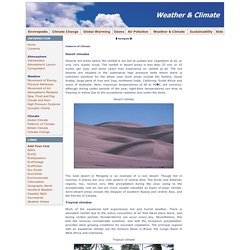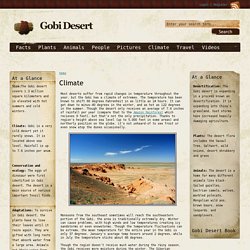

Desert Animal Survival. Chuckwalla Lack of water creates a survival problem for all desert organisms, animals and plants alike.

But animals have an additional problem -- they are more susceptible to extremes of temperature than are plants. Animals receive heat directly by radiation from the sun, and indirectly, by conduction from the substrate (rocks and soil) and convection from the air. The biological processes of animal tissue can function only within a relatively narrow temperature range. When this range is exceeded, the animal dies. Scorpion. Hyena. List of Desert Animals. Da947648d1c80e4fded827898da61b2c. Animal Life. Deserts are among the most inhospitable environments for animal life.

The blistering daylight hours do not see much activity, but a few animals, like lizards, move at high speed across the burning sand in pursuit of insects. With nightfall, the desert comes alive. Large spiders, centipedes and scorpions crawl out from holes or from under stones. Many species of rats and mice are adapted to desert life. They include the grasshopper mice and kangaroo rats of American deserts and the spiny mice, gerbils and jerboas of Africa. Survival Since water is so scarce, most desert animals get their water from the food they eat: succulent plants, seeds, or the blood and body tissues of their prey. Some, like kangaroo rats and lizards, live in burrows which do not get too hot or too cold and have more humid (damp) air inside.
DESERT ANIMAL FACTS. What do desert animals eat? Behavioral and physical adaptations help desert animals survive under extreme conditions.

Some of the things that desert animals eat are detailed below. Carcasses: since there is a shortage of food in the desert, many animals living in the desert resort to scavenging. This means they are able to eat remains of dead animals. This is especially true of animals like vultures, coyotes, dingoes and foxes. Plants: there are several plant species that are able to survive in the desert. All About Desert Animals. Desert Information and Facts. Far from being barren wastelands, deserts are biologically rich habitats with a vast array of animals and plants that have adapted to the harsh conditions there.

Some deserts are among the planet's last remaining areas of total wilderness. Yet more than one billion people, one-sixth of the Earth's population, actually live in desert regions. What Is a Desert? Deserts cover more than one fifth of the Earth's land, and they are found on every continent. A place that receives less than 10 inches (25 centimeters) of rain per year is considered a desert. And despite the common conceptions of deserts as dry and hot, there are cold deserts as well.
The driest deserts get less than half an inch (one centimeter) of precipitation each year, and that is from condensed fog, not rain. World Deserts Map. Deserts of the World. Desert Geography - Desert Biome. Desert Biomes: Facts, Climate & Locations. Geographic Features - Desert Biome. Desert Climate. Desert Climate Deserts are areas where the rainfall is too low to sustain any vegetation at all, or only very scanty scrub.

The rainfall in desert areas is less than 250 mm or 10 inches per year, and some years may experience no rainfall at all. The hot deserts are situated in the subtropical climate zone where there is unbroken sunshine for the whole year due to the stable descending air and high pressure. Such areas include the Sahara, Saudi Arabia, large parts of Iran and Iraq, northwest India, California, South Africa and much of Australia. Here, maximum temperatures of 40 to 45C are common, although during colder periods of the year, night-time temperatures can drop to freezing or below due to the exceptional radiation loss under the clear skies. Continental. Navigate Patterns of Climate Desert climates Deserts are areas where the rainfall is too low to sustain any vegetation at all, or only very scanty scrub.

Cairo Climate Cairo Temperatures Cairo Weather Averages. Hot and Dry Climate - The Desert. Gobi Desert. Most deserts suffer from rapid changes in temperature throughout the year, but the Gobi has a climate of extremes.

The temperature has been known to shift 60 degrees Fahrenheit in as little as 24 hours. It can get down to minus-40 degrees in the winter, and as hot as 122 degrees in the summer. Though the desert only receives an average of 7.6 inches of rainfall per year (compare that to the Amazon Rainforest which recieves 9 feet), but that's not the only precipitation. Thanks to region's height above sea level (up to 5,000 feet in some areas) and northerly position on the globe, it's not unheard-of to see frost or even snow atop the dunes occasionally. Desert Climate. The Desert Climate. Desert Climate. Desert Plants - Cactus - Wildflowers - Flora. Top 9 Plants Commonly found in Deserts - Listovative. What is it that sets a desert apart from other landscapes?

Yes, it is the ocean of sands everywhere till our eyesight start to ache, the low precipitation and high humidity during the day and the drastic fall in temperature at night. There is something else that sets apart deserts, which is its flora. The desert plants are typically beautiful in their own way, plants which we won’t find anywhere else. Desert Plants. For Arid Environments Desert Southwest Planting In the desert Southwest, water is critical to our lives.

We must learn to conserve our water resources without compromising our environment. Home gardeners and landscape professionals can help preserve our water resources by selecting plants that are conducive to the environment. Experienced gardening professionals in the Southwest regions of the country have learned many lessons through the years. Desert Plants & Cactus. Desert Plants. Tplants. Plants in the Desert: Living Survival Aids. By Filip Tkaczyk There are many plants in the desert that can serve as vital aids in wilderness survival.

Some serve as a source of food, some as material for shelters and others serve as the perfect material for friction fires. Knowing your plants can also help lead you to water, the desert’s most precious and elusive resource.